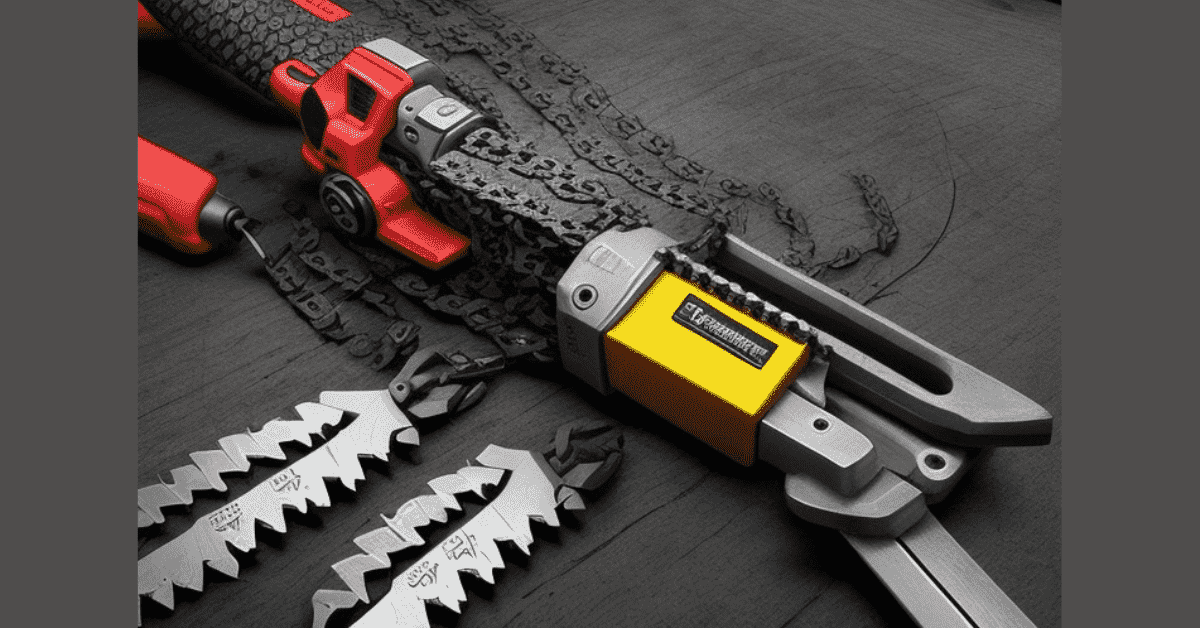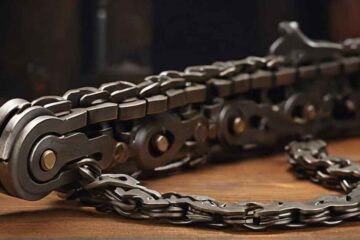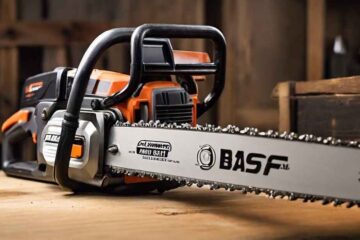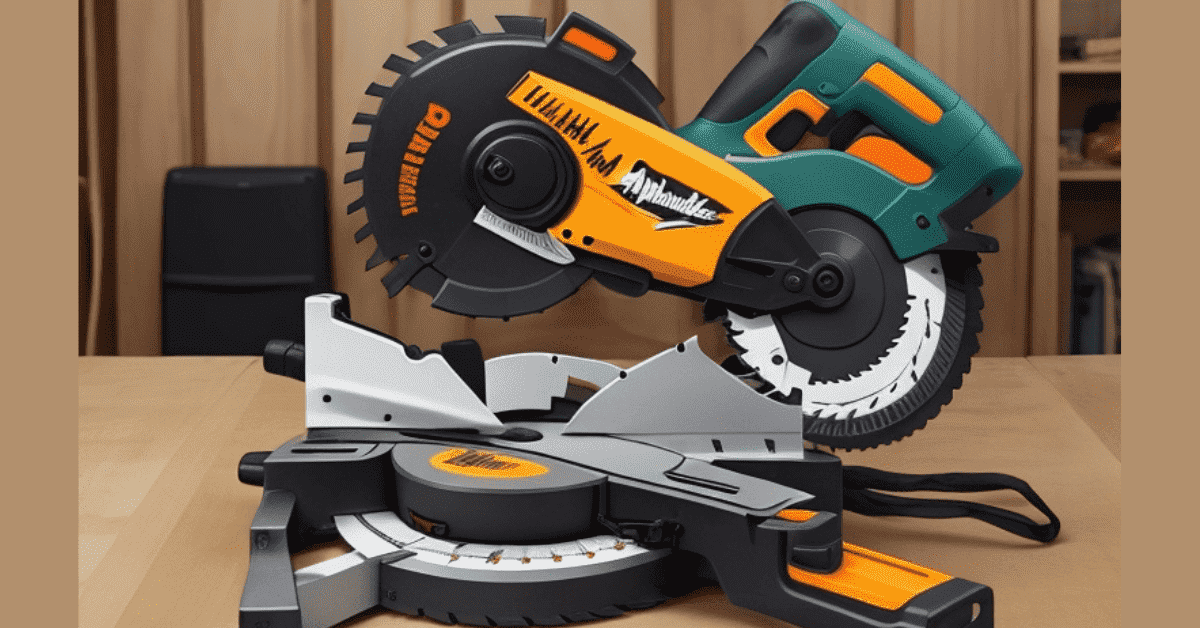Chainsaws are essential tools for a variety of tasks, from felling trees to preparing firewood.
How to shorten chainsaw chain without tool? It is a common question for every wood crafter.
Chainsaw chains can become worn or damaged through normal use and require adjustment or replacement. In some cases, you may need to shorten the chainsaw chain so that it fits correctly on the guide bar. This article details step-by-step how to shorten chainsaw chain without a tool.
Understanding Chainsaw Chains
Types of Chainsaw Chains
- Pitch, gauge, and drive link type are essential factors to consider.
- Pitch is the gap among three consecutive rivets divided by two.
- Gauge is the width of the groove in the guide bar.
- Drive links connect the chain to the guide bar and have a distinct shape.
Choosing a chainsaw chain also takes into account the type of wood and guide bar length.
Here is a table summarizing the different types of chainsaw chains and their applications:
| Type | Gauge | Pitch | Applications |
|---|---|---|---|
| Full chisel | .043″, .050″, or .063″ | 3/8″, .325″, or .404″ | Hardwoods, felling trees, and fast cutting |
| Semi chisel | .043″, .050″, or .063″ | 3/8″, .325″, or .404″ | Softwoods, ripping wood, and reducing kickback |
| Low profile | .043″, .050″, or .063″ | 3/8″, .325″, or .404″ | Reducing vibration and kickback, ideal for homeowners and occasional users |
| Narrow kerf | .037″, .043″, or .050″ | 3/8″, .325″, or .404″ | Reducing cutting resistance and making smooth cuts, ideal for carving and sculpting |
| Ripping | .043″, .050″, or .063″ | 3/8″, .325″, or .404″ | Cutting wood along the grain, ideal for milling lumber |
When to Shorten a Chainsaw Chain
Knowing when to shorten your chainsaw chain is essential for both safety and efficiency. Consider shortening your chain when:
- It Becomes Too Loose: A chain that’s too loose on the bar can lead to poor cutting performance and safety hazards.
- Guide Bar Replacement: If you replace your guide bar with a shorter one, you’ll need to adjust the chain accordingly.
- Switching Chainsaws: When you switch to a different chainsaw model with a smaller guide bar size, your chain may need to be shortened to fit.
Benefits of Shortening a Chainsaw Chain
Shortening a chainsaw chain offers several benefits:
- Improved Cutting Performance: A properly tensioned and sized chain cuts more efficiently, saving you time and effort.
- Reduced Kickback Risk: A loose chain can increase the risk of dangerous kickbacks, which proper tensioning can help prevent.
- Extended Chain Life: Maintaining the correct chain length can prolong its lifespan, saving you money on replacements.
Risks of Shortening a Chainsaw Chain
While shortening a chainsaw chain can be advantageous, it’s important to be aware of potential risks:
- Incorrect Sizing: If not done accurately, shortening can lead to reduced cutting efficiency.
- Safety Hazards: A poorly maintained chain can increase the risk of accidents and dangerous kickbacks.
- Kickback Risk: After shortening, improper tensioning may lead to increased kickback potential.
How to Shorten Chainsaw Chain Without Tool
Follow these user-friendly step-by-step instructions to shorten your chainsaw chain without the need for specialized tools:
Step 1. Identify the Drive Links
- Drive links are the links that connect the chain to the guide bar.
- They are usually larger and have a different shape than the other links.
- Begin by closely examining the chain to locate the first drive link.
Step 2. Find the Correct Length for Your Chain
- Consult your chainsaw’s owner’s manual for the recommended chain length.
- Alternatively, measure the length of your guide bar and subtract the required clearance.
Step 3. Remove the Chain
- To safely remove the chain, release the tension on the chain by loosening the tensioning screw. Then, carefully slip the chain off the guide bar.
Step 4. Clean the Chain
- Before reconnecting the chain, clean it to remove any dirt, debris, or metal shavings that may have accumulated during the shortening process. This ensures optimal performance.
Step 5. Inspect for Wear and Damage
- Examine the chain for signs of wear and damage, such as bent links or worn teeth. Replace any damaged parts.
Step 6. Use Sharp Cutting Tools
- When removing the excess links, use sharp wire cutters or a hacksaw to make clean cuts. This ensures that the chain remains in top condition.
Step 7. Reconnect the Chain
- Gently push the drive links back together until they click into place. Make sure that the chain is properly tensioned by adjusting the tensioning screw on your chainsaw.
Additional Tips for Shortening a Chainsaw Chain Without a Tool
Here are a few extra user-pleasant suggestions to make the chain shortening system secure and successful.
- Wear protection equipment: Always put on protection glasses and gloves to defend yourself from viable injury.
- Proper Chain Tension: Double-test chain anxiety to make sure it’s far well adjusted for finest performance.
- Chain Breaker for Safety Links: If your chain includes safety links, consider using a chain breaker, a tool specifically designed to break and rejoin safety links safely and efficiently.
- Troubleshooting: For help with common problems, consult your chainsaw’s manual.
Frequently Asked Questions (FAQs)
What is a chainsaw chain?
A chainsaw chain is a rotating chain that cuts wood. It consists of interconnected links that are driven around a guide bar by a sprocket.
Why might I need to shorten my chainsaw chain?
There are a few reasons why you might need to shorten your chainsaw chain:
- Your chain may have become too loose over time due to wear and tear.
- You may have replaced your guide bar with a shorter one.
- You may have switched to a different chainsaw model with a smaller guide bar size.
What are the risks of shortening a chainsaw chain without a tool?
If done incorrectly, shortening a chainsaw chain without a tool can be dangerous. Potential risks include:
- Incorrect sizing: If you do not shorten the chain to the correct length, it may not fit properly on the guide bar or it may not be properly tensioned. This can lead to poor cutting performance and safety hazards.
- Safety hazards: A poorly maintained chainsaw chain can increase the risk of accidents and dangerous kickbacks.
- Increased kickback risk after shortening: If the chain is not properly tensioned after shortening, it may be more likely to kick back.
How do I identify the drive links on a chainsaw chain?
Drive links are the links that connect the chain to the guide bar. They are usually larger and have a different shape than the other links. You can consult your chainsaw’s owner’s manual or search online for images of your specific chain to identify the drive links.
How do I determine the correct length for my chainsaw chain?
The correct length for your chainsaw chain will depend on the length of your guide bar. You can consult your chainsaw’s owner’s manual or measure the length of your guide bar and subtract the required clearance.
How do I safely remove a chainsaw chain?
To safely remove a chainsaw chain, first release the tension on the chain by loosening the tensioning screw. Then, carefully slip the chain off the guide bar.
How do I reconnect a chainsaw chain?
To reconnect a chainsaw chain, first align the drive links with the corresponding slots on the guide bar. Then, gently push the drive links back together until they click into place. Make sure that the chain is properly tensioned by adjusting the tensioning screw on your chainsaw.
Conclusion
Shortening a chainsaw chain without tools is a valuable skill. It helps maintain the cutting performance of your chainsaw. I hope you learned more from our article: How to shorten chainsaw chain without tool. By following the user-pleasant commands and protection precautions mentioned in this article, you may be capable of using your chainsaw effectively and safely.




